annual report1-final.qxd - Overseas Indian
annual report1-final.qxd - Overseas Indian
annual report1-final.qxd - Overseas Indian
You also want an ePaper? Increase the reach of your titles
YUMPU automatically turns print PDFs into web optimized ePapers that Google loves.
Parallel Sessions<br />
incrementally over a period of five years. These<br />
scholarships would be awarded for pursuing<br />
undergraduate courses in both technical and nontechnical<br />
streams.<br />
There were plans to establish new educational<br />
institutions in India and abroad and expand existing<br />
facilities in higher education. Currently, only<br />
societies or trusts could establish educational institutions<br />
on non-profit basis. For this, there was a<br />
need to get NOC from the State or Central<br />
Governments and affiliations from the Universities<br />
or other educational bodies. There was no Act yet<br />
for establishing private universities under the<br />
Government of India. However, there were some<br />
State Governments who had taken a lead and given<br />
permission for establishment of private universities,<br />
Banerjee said.<br />
In order to accelerate the process, GoI was willing<br />
to bring in changes in statutory provision in<br />
bodies of higher learning like UGC, AICTE,<br />
Medical Council of India, etc. to facilitate increasing<br />
participation of private players in promoting<br />
higher education. There was a proposal to start an<br />
exclusive university for PIOs and increase the<br />
number of seats for the children of the diaspora.<br />
There was a need to create a select group or task<br />
force to identify the priority areas and changes<br />
required for legislation, do more aggressive marketing<br />
and help develop world-class infrastructure<br />
in the education sector, she said.<br />
Prof. Alagh commented that <strong>Indian</strong> education<br />
was now in a fairly exciting state. Out of the top 52<br />
software companies, 32 were <strong>Indian</strong>. There was<br />
already a private-public partnership in social and<br />
infrastructure areas. There was a plan to extend<br />
this to education. <strong>Overseas</strong> <strong>Indian</strong>s should grab<br />
this opportunity, he said.<br />
Dr. Ramachandran outlined the success story of<br />
BITS-UAE centre in Dubai as an example of establishing<br />
institutions of higher learning outside<br />
India. There was a high appreciation for the quality<br />
of education imparted by <strong>Indian</strong> institutions of<br />
higher learning in UAE. BITS-UAE was sought<br />
after not only by the NRIs but also by citizens of<br />
UAE, Pakistan and Bangladesh, besides others. The<br />
degrees offered by <strong>Indian</strong> institutions were recognised<br />
by institutions abroad.<br />
Dr. H.S. Ballal narrated the success story of MAHE<br />
and highlighted the vision of its founder, Dr.<br />
Ramdas Pai, who initiated the movement of private<br />
participation in education. At present, they had two<br />
universities with professional colleges including<br />
engineering and medical. They also had a large networking<br />
with different institutions across the globe.<br />
Given a chance, they would like to be partners in<br />
establishment of an exclusive university for PIOs<br />
given their experience and wherewithal, he said.<br />
Ravi Seethapathy pointed out that the drawback<br />
of <strong>Indian</strong> higher education was shortage of quality<br />
teachers. He also felt that there was need to impart<br />
skills at different levels of education to students,<br />
and evolve leadership courses at the grassroots, etc.<br />
He emphasised on the need for developing interdisciplinary<br />
education, which was a new concept in<br />
secondary education in Canada and elsewhere. He<br />
felt that private-public partnership was a way forward<br />
to augment R&D and this should be given priority.<br />
He observed that networking and synergy<br />
were the keys to improve the current situation in<br />
education.<br />
The discussions during the question and answer<br />
session reflected on the need for providing spiritual<br />
and cultural education, which was the strength<br />
of India, in educational institutions. As a part of<br />
this, it was suggested that courses in yoga and spiritual<br />
lessons should be part of a comprehensive<br />
curriculum. The <strong>Indian</strong> educational administration<br />
did not recognise these courses whereas students<br />
in U.S. were given certain credits for this.<br />
Dr. Bikas Sanyal cautioned that higher education<br />
came under GATT agreement of WTO and India<br />
should be well prepared to meet its challenges.<br />
S. Krishna Kumar, Secretary, MOIA, called for<br />
efforts to overcome hurdles and remove bottlenecks<br />
in starting new educational institutions and<br />
collaborations. In this regard, participants could<br />
organise groups and come out with suggestions as<br />
to what the GoI could do to make the process less<br />
cumbersome and more transparent. The suggestion<br />
was made in the light of Prime Minister’s suggestion<br />
of starting an organisation on the lines of<br />
the British Council.<br />
38



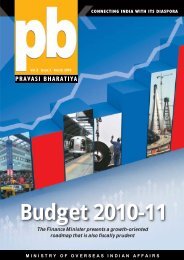
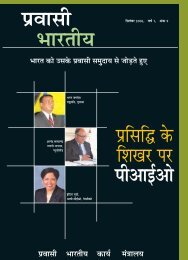



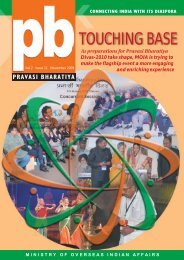
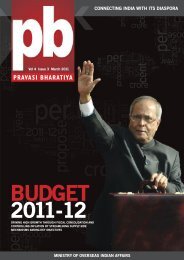

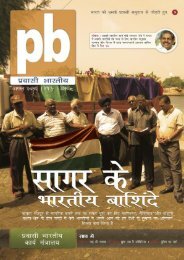
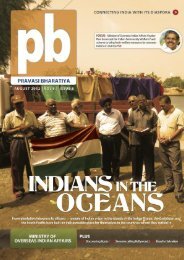
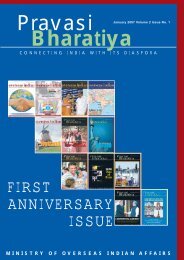


![flaxkiqj feuh izoklh Hkkjrh; fnol] vDVwcj 9&11 - Overseas Indian](https://img.yumpu.com/43977040/1/184x260/flaxkiqj-feuh-izoklh-hkkjrh-fnol-vdvwcj-911-overseas-indian.jpg?quality=85)
